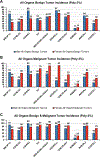Single nucleotide polymorphism patterns associated with a cancer resistant phenotype
- PMID: 35872013
- PMCID: PMC10463559
- DOI: 10.1016/j.yexmp.2022.104812
Single nucleotide polymorphism patterns associated with a cancer resistant phenotype
Abstract
Background and aims: In this study ten mouse strains representing ~90% of genetic diversity in laboratory mice (B6C3F1/J, C57BL/6J, C3H/HeJ, A/J, NOD.B1oSnH2/J, NZO/HILtJ, 129S1/SvImJ, WSB/EiJ, PWK/PhJ, CAST/EiJ) were examined to identify the mouse strain with the lowest incidence of cancer. The unique single polymorphisms (SNPs) associated with this low cancer incidence are reported.
Methods: Evaluations of cancer incidence in the 10 mouse strains were based on gross and microscopic diagnosis of tumors. Single nucleotide polymorphisms (SNPs) in the coding regions of the genome were derived from the respective mouse strains located in the Sanger mouse sequencing database and the B6C3F1/N genome from the National Toxicology Program (NTP).
Results: The WSB strain had an overall lower incidence of both benign and malignant tumors compared to the other mouse strains. At 2 years, the incidence of total malignant tumors (Poly-3 incidence rate) ranged from 2% (WSB) to 92% (C3H) in males, and 14% (WSB) to 93% (NZO) in females, and the total incidence of benign and malignant tumor incidence ranged from 13% (WSB) to 99% (C3H) in males and 25% (WSB) to 96% (NOD) in females. Single nucleotide polymorphism (SNP) patterns were examined in the following strains: B6C3F1/N, C57BL/6J, C3H/HeJ, 129S1/SvImJ, A/J, NZO/HILtJ, CAST/EiJ, PWK/PhJ, and WSB/EiJ. We identified 7519 SNPs (involving 5751 Ensembl transcripts of 3453 Ensembl Genes) that resulted in a unique amino acid change in the coding region of the WSB strain.
Conclusions: The inherited genetic patterns in the WSB cancer-resistant mouse strain occurred in genes involved in multiple cell functions including mitochondria, metabolic, immune, and membrane-related cell functions. The unique SNP patterns in a cancer resistant mouse strain provides insights for understanding and developing strategies for cancer prevention.
Keywords: Cancer; Immune; Membrane-related functions; Metabolic; Mitochondria; Mouse strains; Single nucleotide polymorphisms.
Copyright © 2022 Elsevier Inc. All rights reserved.
Conflict of interest statement
Declaration of Competing Interest The authors declare that they have no competing interests.
Figures
Similar articles
-
Influenza H3N2 infection of the collaborative cross founder strains reveals highly divergent host responses and identifies a unique phenotype in CAST/EiJ mice.BMC Genomics. 2016 Feb 27;17:143. doi: 10.1186/s12864-016-2483-y. BMC Genomics. 2016. PMID: 26921172 Free PMC article.
-
Islet proteomics reveals genetic variation in dopamine production resulting in altered insulin secretion.J Biol Chem. 2018 Apr 20;293(16):5860-5877. doi: 10.1074/jbc.RA117.001102. Epub 2018 Mar 1. J Biol Chem. 2018. PMID: 29496998 Free PMC article.
-
Genetic context modulates aging and degeneration in the murine retina.Mol Neurodegener. 2025 Jan 20;20(1):8. doi: 10.1186/s13024-025-00800-9. Mol Neurodegener. 2025. PMID: 39833899 Free PMC article.
-
Diet-induced obesity in genetically diverse collaborative cross mouse founder strains reveals diverse phenotype response and amelioration by quercetin treatment in 129S1/SvImJ, PWK/EiJ, CAST/PhJ, and WSB/EiJ mice.J Nutr Biochem. 2021 Jan;87:108521. doi: 10.1016/j.jnutbio.2020.108521. Epub 2020 Oct 8. J Nutr Biochem. 2021. PMID: 33039581
-
The Collaborative Cross mouse model for dissecting genetic susceptibility to infectious diseases.Mamm Genome. 2018 Aug;29(7-8):471-487. doi: 10.1007/s00335-018-9768-1. Epub 2018 Aug 24. Mamm Genome. 2018. PMID: 30143822 Review.
References
-
- Akdis M, et al., 2011. Interleukins, from 1 to 37, and interferon-γ: Receptors, functions, and roles in diseases. Journal of Allergy and Clinical Immunology. 127, 701–721.e70. - PubMed
-
- Bailer AJ, Portier CJ, 1988. Effects of treatment-induced mortality and tumor-induced mortality on tests for carcinogenicity in small samples. Biometrics. 44, 417–31. - PubMed
Publication types
MeSH terms
Substances
Grants and funding
LinkOut - more resources
Full Text Sources
Medical
Miscellaneous



